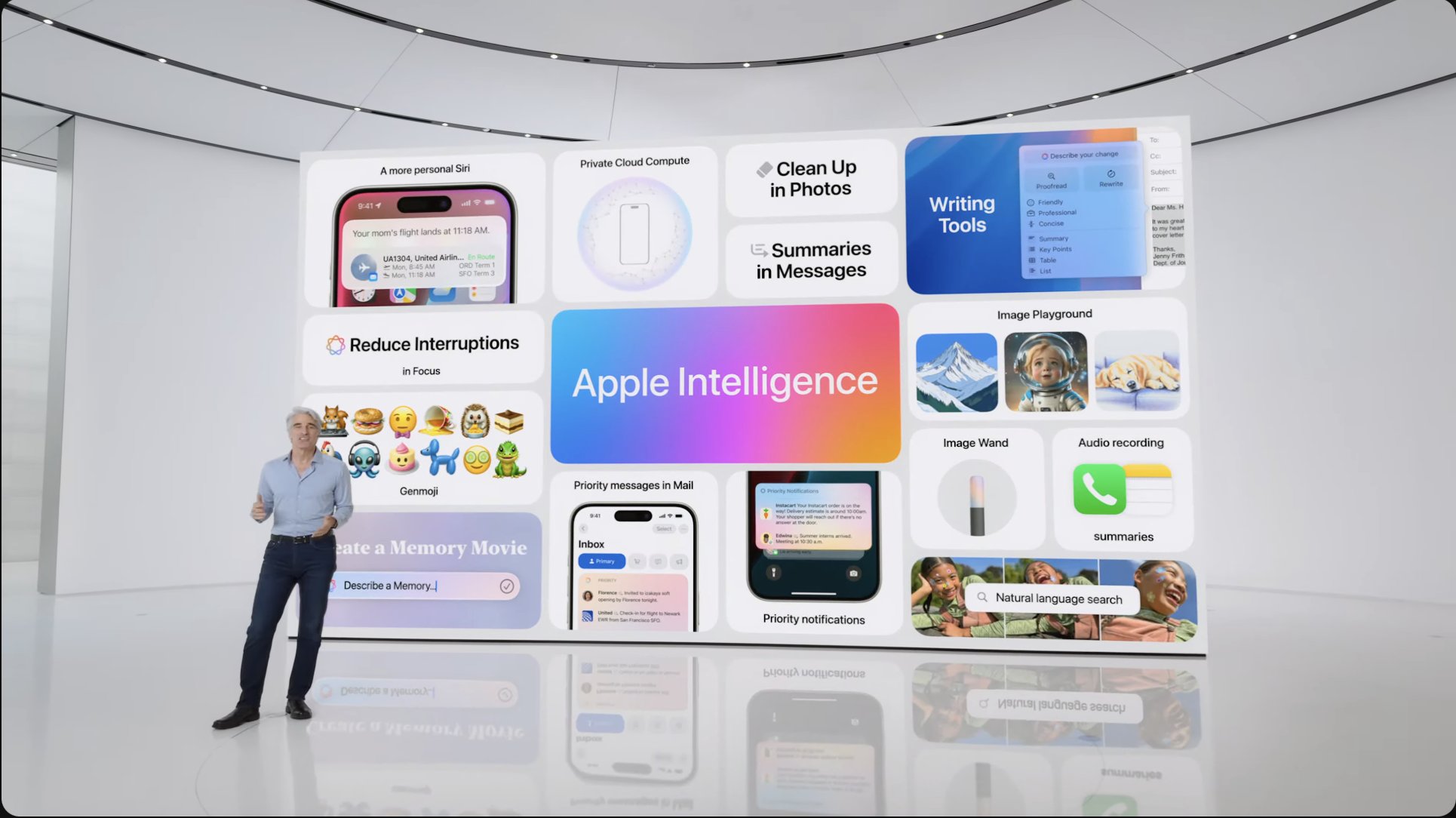With a mix of long-awaited features and innovative advancements, Apple has set a new standard for tech in 2024. Let’s dive into every major announcement and explore the new capabilities that are set to redefine our digital experiences.
Key Highlights
Vision OS 2.0: Enhancements for an Immersive Experience
Apple introduced Vision OS 2.0, building on the capabilities of its Vision Pro. Despite being less than half a year since the initial release, Vision OS 2.0 offers several key updates:
- Wrist Turn Gesture: This new gesture allows users to quickly check the time and battery percentage without interrupting their workflow. The control center is now more accessible, eliminating the need to look up at the ceiling as in the previous version.
- Immersive Media Features: Apple has leveraged advanced machine learning to convert old photos into spatial photos, creating a more immersive viewing experience. Additionally, new tools help users create spatial and immersive videos on cameras other than the iPhone, though they can only be viewed on a Vision Pro.
- Enhanced Mac Mirroring: With foveated rendering now happening on the Mac, users can enjoy up to double the resolution, allowing for a gigantic ultra-wide display. This improvement frees up resources and enhances productivity with more room for windows and activities.
These updates, while significant, might not justify the “2.0” label, feeling more like incremental improvements to the existing system.
iOS 18: A Customization Revolution
iOS 18 represents a significant shift in how users interact with their iPhones, introducing features that Android users have long enjoyed:
- Home Screen Customization: For the first time, users can place icons anywhere on the home screen grid. This seemingly simple feature was met with applause, highlighting its importance to iPhone users.
- Theme Engine: This new feature allows users to change the color of every icon and widget on their home screen to match their wallpaper. While this level of customization has been available on Android for years, it marks a new era for iPhone users, allowing for unique and personalized home screens.
- Redesigned Control Center: The control center is now fully customizable across multiple pages, offering more shortcuts and improved functionality. Users can finally replace the flashlight and camera icons on the home screen without jailbreaking their devices.
- Hidden Apps and Scheduled Texts: Users can now lock apps into a hidden folder, providing better privacy. Additionally, iMessage now supports scheduled text messages and text formatting, enhancing the messaging experience.
- Game Mode: This mode minimizes background activity and reduces Bluetooth latency for peripherals, ensuring a smoother gaming experience.
- Photos App Redesign: The new photos app includes automatic categorization and a game mode that minimizes background activity.
While these features might seem basic to Android users, they are groundbreaking for iPhone users and signal a new level of customization and functionality.
Apple Intelligence: The New Face of AI
Apple has rebranded its AI efforts under the name “Apple Intelligence,” introducing a suite of generative models and smart features across its devices. Here’s what you need to know:
- Writing Tools: These tools leverage large language models to offer capabilities like summarizing, rewriting, changing writing styles, and proofreading text. Whether you’re using Pages or Keynote, these tools can enhance your writing process.
- Cleanup Tool in Photos: Similar to Google’s Magic Eraser, this tool allows users to remove unwanted items from photos and fill in the background using generative fill technology.
- Generative Emojis: Users can now create new emojis on the fly by typing a prompt. The diffusion model generates the emoji in the style of existing ones, allowing for personalized expression.
- Image Playground: This new app and feature within Apple’s suite allow users to create images in three styles: sketch, illustration, and animation. The image playground lets users generate creative visuals with simple prompts.
- Enhanced Siri: Siri now uses large language models to better understand context and offer more natural responses. Later in the year, Siri will be able to pull information from apps and perform actions within them, improving its utility as an assistant.
These features are exclusive to devices with the latest Apple silicon, such as the iPhone 15 Pro, iPads with M1 or later, and Macs with M1 or later.
Mac OS Sequoia: Bringing Continuity to New Heights
Mac OS Sequoia introduces several new features designed to improve user experience and productivity:
- Window Snapping: Built-in window snapping is now available, eliminating the need for third-party apps. This feature makes multitasking easier and more efficient.
- iPhone Mirroring: This continuity feature allows users to wirelessly mirror their iPhone on their Mac, merging notifications and audio. Users can drag and drop items between their devices seamlessly, enhancing workflow.
- Standalone Password App: The new password app, previously buried in settings, is now a standalone application available on Mac, iPad, and iPhone. This change makes password management more accessible and user-friendly.
These updates aim to create a more integrated and cohesive experience across Apple devices, making it easier for users to switch between their iPhone and Mac.
AI and Privacy: A Delicate Balance
Apple has taken a unique approach to AI and privacy, ensuring that most AI tasks are processed on-device. This method maintains user privacy while delivering powerful AI capabilities. Here’s how it works:
- On-Device Processing: Most AI features, such as handwriting recognition and context understanding, are processed directly on the device using Apple’s built-in models. This approach ensures fast and secure operation.
- Private Cloud Compute: For more complex tasks, data can be processed on Apple’s private cloud servers, which use Apple silicon. This method maintains privacy by not storing or sending data to Apple.
- Integration with OpenAI: When users request tasks beyond Apple’s models’ capabilities, the device can ask for permission to use OpenAI’s ChatGPT-4. This feature ensures transparency and user control, asking for consent each time.
Apple’s commitment to privacy ensures that even when data is processed in the cloud, user information remains secure and anonymous.
Real-World Impact: Competitors in a Tough Spot
The advancements in Apple Intelligence highlight the challenges faced by competitors like the Humane Pin and Rabbit R1. These new products, despite their innovations, struggle to match the deep integration and personalization offered by Apple’s ecosystem. With Apple leveraging its extensive data and advanced silicon, competitors have a tough act to follow.
In-Depth Feature Exploration
Let’s delve deeper into some of the standout features announced at WWDC 2024 and explore their potential impact and applications.
Vision OS 2.0: A Closer Look
Vision OS 2.0’s enhancements might seem minor, but they signify important strides in usability and integration:
- Wrist Turn Gesture: This intuitive gesture is a game-changer for users who rely on quick access to information without disrupting their immersive experience. It’s particularly useful in professional settings where every second counts.
- Immersive Media Features: Transforming old photos into spatial photos could revolutionize how we relive memories. Imagine revisiting a family vacation with a newfound depth and perspective, making the experience more engaging.
- Mac Mirroring: The improved resolution and resource management mean that users can work on larger and more detailed projects seamlessly. This feature is especially beneficial for creative professionals who need ample screen real estate.
iOS 18: Ushering in a New Era of Customization
The customization features in iOS 18 are a significant shift for Apple:
- Icon Placement and Theme Engine: These features allow users to create a truly personalized home screen. This level of customization can enhance productivity by allowing users to arrange their apps in a way that suits their workflow.
- Redesigned Control Center: A customizable control center means users can access their most-used features quickly and efficiently. This update could streamline daily tasks and improve overall device usability.
- Hidden Apps and Scheduled Texts: Enhanced privacy and convenience are always welcome. Being able to hide apps and schedule messages allows users to maintain control over their personal information and communication.
Apple Intelligence: The Future of AI on Apple Devices
Apple Intelligence is set to redefine AI interaction on Apple devices:
- Writing Tools: These tools can save time and effort in creating polished documents. Whether you’re drafting an email or working on a presentation, the ability to rewrite and proofread text using AI can significantly enhance productivity.
- Cleanup Tool in Photos: Removing unwanted elements from photos can improve the quality and appeal of images, making them more shareable and professional.
- Generative Emojis and Image Playground: These creative tools cater to a younger, more expressive audience. The ability to generate custom emojis and images can add a fun and personalized touch to digital communication.
- Enhanced Siri: Improved context understanding and the ability to perform tasks within apps make Siri a more valuable assistant. This enhancement could lead to more seamless and efficient device interaction.
Mac OS Sequoia: Seamless Integration
Mac OS Sequoia’s new features enhance user experience and continuity:
- Window Snapping: This long-awaited feature simplifies multitasking, allowing users to arrange their workspace more efficiently. It’s a small but significant improvement for productivity.
- iPhone Mirroring: The ability to mirror and interact with your iPhone on a Mac can streamline workflows, especially for users who rely on both devices. This feature can save time and reduce the friction of switching between devices.
- Standalone Password App: By making password management more accessible, Apple is addressing a common user pain point. This change can enhance security and user convenience.
Privacy and AI: Ensuring User Trust
Apple’s approach to AI and privacy is a careful balancing act:
- On-Device Processing: Keeping most AI tasks on-device ensures user data remains private and secure
. This approach aligns with Apple’s longstanding commitment to user privacy.
- Private Cloud Compute and OpenAI Integration: For tasks that require more processing power, Apple’s private cloud servers offer a secure solution. The integration with OpenAI, while ensuring user consent, provides additional capabilities without compromising privacy.
The Competitive Landscape: Challenges Ahead
Apple’s advancements in AI and integration pose significant challenges for competitors:
- Humane Pin and Rabbit R1: These new products must offer compelling features and integration to compete with Apple’s ecosystem. The depth of Apple’s integration and personalization options makes it difficult for new entrants to match the user experience.
- Industry Impact: Apple’s approach to AI and privacy sets a new standard for the industry. Competitors will need to prioritize privacy and offer seamless integration to stay relevant.
Conclusion: A New Era for Apple Users
Apple’s commitment to innovation and user experience. From enhanced customization in iOS 18 to the powerful new features in Apple Intelligence and Mac OS Sequoia, Apple is setting the stage for a more integrated and personalized digital future. The emphasis on privacy and user control ensures that these advancements enhance user experience without compromising trust.
As we look forward to exploring these new features, it’s clear that Apple’s ecosystem is becoming more powerful and cohesive, offering users a seamless and secure experience across all their devices. Whether you’re a casual user or a professional, there’s something to look forward to in Apple’s latest updates. Stay tuned for in-depth reviews and hands-on experiences as these features roll out.









